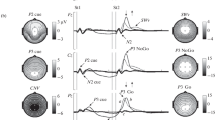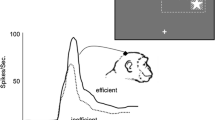Abstract
The study evaluated whether a parallel factor analysis model is adequate and efficient in describing the event-related potentials (ERPs). ERPs evoked in a visual Go/NoGo task were recorded in 351 healthy subjects aged 18–55 years. The parallel factor analysis made it possible to separate the ERP components that differed in topography and waveform; the latter components proved to depend on the type of a subject’s response. The magnitudes of the components were individual, varied among subjects, and were mutually uncorrelated. Based on our results, the parallel factor analysis was concluded to provide an adequate approach for describing common characteristics and individual features of ERPs.



Similar content being viewed by others
REFERENCES
Kropotov, Yu.D., Kolichestvennaya EEG, kognitivnye vyzvannye potentsialy mozga cheloveka i neiroterapiya (Quantitative EEG, Cognitive Event-Related Human Brain Potentials and Neurotherapy), Donetsk: Izd. Yu.A. Zaslavskii, 2010.
The Oxford Handbook of Event-Related Potential Components, Luck, S.J. and Kappenman, E.S., Eds., Oxford: Oxford Univ. Press, 2011.
Nunez, P.L. and Srinivasan, R., Electric Field of the Brain: The Neurophysics of EEG, New York: Oxford Univ. Press, 2006, 2nd ed.
Grech, R., Cassar, T., Muscat, J., et al., Review on solving the inverse problem in EEG source analysis, J. Neuroeng. Rehabil., 2008, vol. 5, no. 25.
Wipf, D., Owen, J., Attias, H., et al., Robust Bayesian estimation of the location, orientation, and time course of multiple correlated neural sources using MEG, NeuroImage, 2010, vol. 49, p. 641.
EEG/ERP Analysis: Methods and Applications, Kamel, N. and Malik, A.S., Eds., Boca Raton: CRC Press, 2015.
Liu, K., Yu, Z.L., Wu, W., et al., Bayesian electromagnetic spatio-temporal imaging of extended sources with Markov Random Field and temporal basis expansion, NeuroImage, 2016, vol. 139, p. 385.
Handbook of Blind Source Separation: Independent Component Analysis and Applications, Comon, P. and Jutten, C., Eds., New York: Academic, 2010.
Wu, W., Chen, Z., Gao, X., et al., Probabilistic common spatial patterns for multichannel EEG analysis, IEEE Trans. Pattern Anal. Mach. Intell., 2015, vol. 37, p. 639.
Ponomarev, V.A. and Kropotov, Yu.D., Improving source localization of event-related potentials in the GO/NOGO task by modeling their cross-covariance structure, Hum. Physiol., 2013, vol. 39, no. 1, p. 27.
Kropotov, J.D. and Ponomarev, V.A., Differentiation of neuronal operations in latent components of event-related potentials in delayed match-to-sample tasks, Psychophysiology, 2015, vol. 52, no. 6, p. 826.
Kropotov, J., Ponomarev, V., Tereshchenko, E.P., et al., Effect of aging on ERP components of cognitive control, Front. Aging Neurosci., 2016, vol. 8, no. 69.
Kropotov, J.D., Ponomarev, V.A., Pronina, M., and Jäncke, L., Functional indexes of reactive cognitive control: ERPs in cued go/no-go tasks, Psychophysiology, 2017, vol. 54, p. 1899.
Kolda, T. and Bader, B., Tensor decompositions and applications, SIAM Rev., 2009, vol. 51, p. 455.
Cichocki, A., Mandic, D., Phan, A.-H., et al., Tensor decompositions for signal processing applications from two-way to multiway component analysis, IEEE Signal Process. Mag., 2015, vol. 32, p. 145.
Cong, F., Lin, Q.H., Kuang, L.D., et al., Tensor decomposition of EEG signals: a brief review, J. Neurosci. Methods, 2015, vol. 248, p. 59.
Zhou, G., Zhao, Q., Zhang, Y., et al., Linked component analysis from matrices to high order tensors: applications to biomedical data, Proc. IEEE, 2016, vol. 104, p. 310.
Vigário, R.N., Extraction of ocular artefacts from EEG using independent component analysis, Electroencephalogr. Clin. Neurophysiol., 1997, vol. 103, no. 3, p. 395.
Comon, P., Luciani, X., and de Almeida, A.L.F., Tensor decompositions, alternating least squares and other tales, J. Chemom., 2009, vol. 23, p. 393.
Panteleev, A.V. and Letova, T.A., Metody optimizatsii v primerakh i zadachakh (Optimization Methods in Examples and Tasks), Moscow: Vysshaya Shkola, 2005, 2nd ed.
Rajih, M., Comon, P., and Harshman, R., Enhanced line search: A novel method to accelerate Parafac, SIAM J. Matrix Anal. Appl., 2008, vol. 30, p. 1148.
Bro, R. and Kiers, H.A.L., A new efficient method for determining the number of components in PARAFAC models, J. Chemom., 2003, vol. 17, p. 274.
Bro, R. and De Jong, S., A fast non-negativity-constrained least squares algorithm, J. Chemom., 1997, vol. 11, p. 393.
Folstein, J.R. and van Petten, C., Influence of cognitive control and mismatch on the N2 component of the ERP, Psychophysiology, 2008, vol. 45, p. 152.
Author information
Authors and Affiliations
Corresponding author
Additional information
Translated by T. Tkacheva
Rights and permissions
About this article
Cite this article
Ponomarev, V.A., Pronina, M.V. & Kropotov, Y.D. Parallel Factor Analysis in the Study of Event-Related Potentials. Hum Physiol 45, 233–241 (2019). https://doi.org/10.1134/S0362119719030150
Received:
Revised:
Accepted:
Published:
Issue Date:
DOI: https://doi.org/10.1134/S0362119719030150




